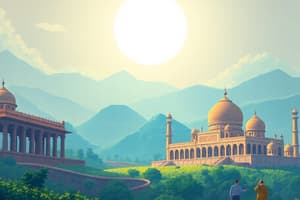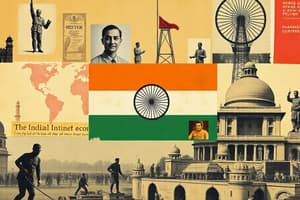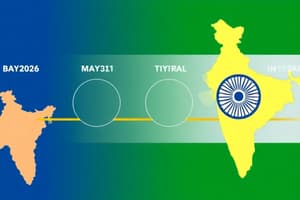Podcast
Questions and Answers
Which of the following best encapsulates the core principle behind India's adoption of economic planning after independence?
Which of the following best encapsulates the core principle behind India's adoption of economic planning after independence?
- Blending socialist and capitalist principles to create a mixed economy model. (correct)
- Prioritizing complete isolation from global markets to foster domestic industries.
- Establishing a purely socialist system with complete state control over all means of production.
- Rapidly privatizing all sectors to align with global capitalist economies.
What was a significant drawback of the public sector's role in India's industrial development during the planning period?
What was a significant drawback of the public sector's role in India's industrial development during the planning period?
- Its inefficient functioning and financial losses strained the nation's resources. (correct)
- Its focus on heavy industries neglected the development of consumer goods.
- Its overwhelming success led to the stagnation of private sector initiatives.
- Its strict regulations prevented any foreign investment in key industries.
How did the Green Revolution primarily benefit Indian farmers?
How did the Green Revolution primarily benefit Indian farmers?
- By promoting organic farming practices, reducing reliance on chemical inputs.
- By introducing High Yielding Variety (HYV) seeds, increasing agricultural output and productivity. (correct)
- By redistributing land ownership, ensuring equitable access to resources for all farmers.
- By stabilizing market prices for agricultural products through government intervention.
What was the primary objective behind India's import substitution policy in the industrial sector?
What was the primary objective behind India's import substitution policy in the industrial sector?
Which combination of factors best explains why the proportion of people dependent on agriculture in India did not decline as expected after independence?
Which combination of factors best explains why the proportion of people dependent on agriculture in India did not decline as expected after independence?
What is the potential trade-off associated with subsidies in the agricultural sector?
What is the potential trade-off associated with subsidies in the agricultural sector?
A central planning authority sets ambitious industrial growth targets but overlooks investments in human capital and infrastructure. Which of the following is the most likely consequence?
A central planning authority sets ambitious industrial growth targets but overlooks investments in human capital and infrastructure. Which of the following is the most likely consequence?
If a developing economy focuses solely on maximizing GDP growth while neglecting environmental protection and equitable distribution of wealth, what scenario is most likely to occur?
If a developing economy focuses solely on maximizing GDP growth while neglecting environmental protection and equitable distribution of wealth, what scenario is most likely to occur?
Which of the following best describes the fundamental questions addressed by India's Five Year Plans regarding economic production and distribution?
Which of the following best describes the fundamental questions addressed by India's Five Year Plans regarding economic production and distribution?
Imagine a scenario where a farming family is deciding whether to invest in new machinery or hire more laborers. Which goal of the Five Year Plans does this decision directly relate to?
Imagine a scenario where a farming family is deciding whether to invest in new machinery or hire more laborers. Which goal of the Five Year Plans does this decision directly relate to?
Which of the following activities would be most effective in understanding the changes in agricultural practices and their economic impact, as suggested in the content?
Which of the following activities would be most effective in understanding the changes in agricultural practices and their economic impact, as suggested in the content?
If a group of students is preparing a chart to show variations in agricultural production, what would be the MOST relevant parameters to include, based on the content?
If a group of students is preparing a chart to show variations in agricultural production, what would be the MOST relevant parameters to include, based on the content?
What is the primary purpose of collecting newspaper cuttings related to the World Bank, IMF, and WTO, according to the provided content?
What is the primary purpose of collecting newspaper cuttings related to the World Bank, IMF, and WTO, according to the provided content?
Suppose the occupational structure of the Indian economy has shifted significantly from 1950-51 to the present. Based on the prompt, which of the following analyses would provide the MOST relevant insights into this shift:
Suppose the occupational structure of the Indian economy has shifted significantly from 1950-51 to the present. Based on the prompt, which of the following analyses would provide the MOST relevant insights into this shift:
Consider the debate around agricultural subsidies. What would be a balanced approach to evaluating their merit?
Consider the debate around agricultural subsidies. What would be a balanced approach to evaluating their merit?
In the context of India's development policies from 1950-1990, which of the following reflects the MOST likely reason for the emphasis on a regulated economy?
In the context of India's development policies from 1950-1990, which of the following reflects the MOST likely reason for the emphasis on a regulated economy?
Flashcards
India's Five Year Plans
India's Five Year Plans
Strategic blueprints for economic development in India.
Development Policies (1950-1990)
Development Policies (1950-1990)
Policies aimed at improving sectors like agriculture and industry.
Regulated Economy Merits
Regulated Economy Merits
Benefits of government intervention in the economy.
Regulated Economy Limitations
Regulated Economy Limitations
Signup and view all the flashcards
Production Decisions
Production Decisions
Signup and view all the flashcards
Agricultural Subsidies Debate
Agricultural Subsidies Debate
Signup and view all the flashcards
Occupational Structure of India
Occupational Structure of India
Signup and view all the flashcards
International Economic Organizations
International Economic Organizations
Signup and view all the flashcards
Mixed Economy Model
Mixed Economy Model
Signup and view all the flashcards
Five Year Plans
Five Year Plans
Signup and view all the flashcards
Green Revolution
Green Revolution
Signup and view all the flashcards
High Yielding Variety (HYV) Seeds
High Yielding Variety (HYV) Seeds
Signup and view all the flashcards
Import Substitution Policy
Import Substitution Policy
Signup and view all the flashcards
Marketable Surplus
Marketable Surplus
Signup and view all the flashcards
Self-Reliance
Self-Reliance
Signup and view all the flashcards
Public Sector
Public Sector
Signup and view all the flashcards
Study Notes
Indian Economy 1950-1990
- Learners will understand the goals of India's five-year plans.
- Learners will study development policies in sectors like agriculture and industry from 1950-1990.
- Learners will assess the merits and limitations of a regulated economy.
Introduction
- India gained independence on August 15, 1947.
- Jawaharlal Nehru, the first prime minister, favored a socialist economic system.
- Nehru and other leaders sought an alternative to extreme forms of capitalism and socialism.
- They aimed to improve living standards & create opportunities for a richer life.
Types of Economic Systems
- A market economy (capitalism) relies on supply and demand to determine production.
- A socialist economy prioritises the needs of society, with the government controlling production.
- Most economies are mixed, combining elements of both market and government control (e.g. in factors like production, distribution, and ownership).
What is a Plan?
- A plan outlines how a nation's resources are used to achieve specific objectives within a period.
- India used five-year plans, with long-term perspective plans.
- Goals may conflict, requiring planners to prioritize and balance them.
Goals of Five-Year Plans
- Growth is a key goal, aiming to expand the economy's capacity for producing goods and services.
- Self-reliance is important; promoting domestic production and reducing dependence on other countries.
- Modernisation means adopting new technologies to increase production.
- Equity involves ensuring the benefits of growth reach all segments of society, not just the wealthy,
Studying That Suits You
Use AI to generate personalized quizzes and flashcards to suit your learning preferences.




